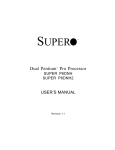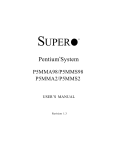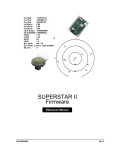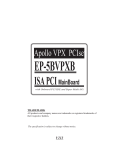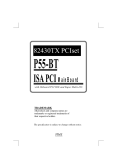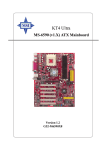Download Get - Supermicro
Transcript
SUPER SUPER P6DLH SUPER P6DLF USER’S MANUAL Revision 1.1 ® The information in this User’s Manual has been carefully reviewed and is believed to be accurate. The vendor assumes no responsibility for any inaccuracies that may be contained in this document, makes no commitment to update or to keep current the information in this manual, or to notify any person or organization of the updates. SUPERMICRO COMPUTER reserves the right to make changes to the product described in this manual at any time and without notice. This product, including software, if any, and documentation may not, in whole or in part, be copied, photocopied, reproduced, translated or reduced to any medium or machine without prior written consent. IN NO EVENT WILL SUPERMICRO COMPUTER BE LIABLE FOR DIRECT, INDIRECT, SPECIAL, INCIDENTAL, OR CONSEQUENTIAL DAMAGES ARISING FROM THE USE OR INABILITY TO USE THIS PRODUCT OR DOCUMENTATION, EVEN IF ADVISED OF THE POSSIBILITY OF SUCH DAMAGES. IN PARTICULAR, THE VENDOR SHALL NOT HAVE LIABILITY FOR ANY HARDWARE, SOFTWARE, OR DATA STORED OR USED WITH THE PRODUCT, INCLUDING THE COSTS OF THE REPAIRING, REPLACING, OR RECOVERING SUCH HARDWARE, SOFTWARE, OR DATA. Unless you request and receive written permission from SUPERMICRO COMPUTER, you may not copy any part of this document. Information in this document is subject to change without notice. Other products and companies referred to herein are trademarks or registered trademarks of their respective companies or mark holders. Copyright © 1997 by SUPERMICRO COMPUTER INC. All rights reserved. Printed in the United States of America. Preface About This Manual This manual is written for system houses, PC technicians and knowledgeable PC end users. It provides information for the installation and use of SUPER P6DLH/P6DLF motherboard. SUPER P6DLH/P6DLF supports Pentium II 233/266/300/333 MHz. The Pentium II processor with the Dual Independent Bus Architecture is housed in a new package technology called the Single Edge Contact (S.E.C.) cartridge. This new cartridge package and its associated "Slot 1" infrastructure will provide the headroom for future high-performance processors. Manual Organization Chapter 1, Introduction, describes the features, specifications and performance of the SUPER P6DLH/P6DLF system board, provides detailed information about the chipset, and offers warranty information. Refer to Chapter 2, Installation, for instructions on how to install the Pentium II processor, the retention mechanism, and the heat sink support. This chapter provides you with the instructions for handling static-sensitive devices. Read this chapter when you want to install or remove SIMM/DIMM memory modules and to mount the system board in the chassis. Also refer to this chapter to connect the floppy and hard disk drives, IDE interfaces, parallel port, serial ports, as well as the cables for the power supply, reset cable, Keylock/Power LED, speaker and keyboard. iii SUPER P6DLH/P6DLF User’s Manual If you encounter any problem, please see Chapter 3, Troubleshooting, which describes troubleshooting procedures for video, memory, and the setup configuration stored in memory. Instructions are also included on contacting a technical assistance support representative and returning merchandise for service and the BBS# for BIOS upgrades. i v Preface Table of Contents Preface About This Manual ......................................................................................... iii Manual Organization ...................................................................................... iii Quick Reference ........................................................................................... viii Chapter 1: 1-1 Overview ............................................................................................... 1-1 SUPER P6DLH ............................................................................. 1-3 SUPER P6DLF .............................................................................. 1-4 SUPER P6DLH Motherboard Layout ........................................ 1-5 SUPER P6DLF Motherboard Layout ........................................ 1-6 SUPER P6DLH Features ............................................................ 1-7 SUPER P6DLF Features ............................................................ 1-9 1-2 PC Health Monitoring ...................................................................... 1-11 1-3 ACPI/PC 98 Features ...................................................................... 1-14 1-4 Chipset Overview .............................................................................. 1-15 1-5 Wake-on-LAN .................................................................................... 1-16 1-6 Power Supply .................................................................................... 1-16 1-7 National Semiconductor Super I/O ................................................ 1-17 1-8 Warranty, Technical Support, and Service .................................. 1-18 Parts .............................................................................................. 1-18 BIOS .............................................................................................. 1-18 Labor ............................................................................................. 1-18 Returns ......................................................................................... 1-18 Chapter 2: Installation 2-1 Pentium II Processor Installation ................................................... 2-1 OEM Pentium II and Heat Sink Support .................................. 2-5 Removing the Pentium II Processor ........................................ 2-6 v SUPER P6DLH/P6DLF User’s Manual 2-2 Static-Sensitive Devices ................................................................... 2-7 Precautions ................................................................................... 2-7 Unpacking ...................................................................................... 2-7 2-3 Changing the CPU Speed ............................................................... 2-7 2-4 Mounting the Motherboard in the Chassis ................................... 2-8 2-5 Connecting Cables ............................................................................ 2-9 Power Supply Connectors .......................................................... 2-9 PW_ON Connector ...................................................................... 2-11 Infrared Connector ...................................................................... 2-11 Reset Connector ........................................................................ 2-12 Keylock/Power LED Connector ............................................... 2-12 Hard Drive LED .......................................................................... 2-13 Speaker Connector .................................................................... 2-13 AT Keyboard Connector ............................................................ 2-14 Universal Serial Bus .................................................................. 2-14 PS/2 Mouse Port .......................................................................... 2-15 Serial Ports .................................................................................. 2-15 Power On/Off State .................................................................... 2-16 SMI ................................................................................................. 2-16 CMOS Clear ................................................................................. 2-17 External Battery ........................................................................... 2-17 Overheat LED .............................................................................. 2-17 Buzzer Overheat Notification .................................................... 2-18 Chassis Intrusion Connector .................................................. 2-18 Power Supply Selection ............................................................ 2-18 Wake-on-LAN .............................................................................. 2-19 Fan Connectors .......................................................................... 2-19 Optional Keyboard Connector ................................................. 2-20 i960 Serial Port ........................................................................... 2-20 i960 Fail LED Indicator ............................................................. 2-21 i960 Initialization Modes ........................................................... 2-21 v i Table of Contents i960 Jumper Settings ................................................................ 2-22 I2C Connector .............................................................................. 2-22 2-6 Installing/Removing SIMM/DIMM Modules .................................. 2-23 SIMM/DIMM Module Installation ............................................... 2-24 Removing DIMM Modules ......................................................... 2-25 Removing SIMM Modules ......................................................... 2-25 2-7 Connecting Parallel, FDD and HDD ............................................ 2-26 Parallel Port Connector ............................................................ 2-27 Floppy Connector ....................................................................... 2-28 IDE Interfaces ............................................................................. 2-29 AGP Port ....................................................................................... 2-30 Chapter 3: Troubleshooting 3-1 Troubleshooting Procedures ........................................................... 3-1 No Video ........................................................................................ 3-1 Troubleshooting Flowchart ........................................................ 3-2 Memory Error ................................................................................. 3-3 Losing the System’s Setup Configuration .............................. 3-3 3-2 Technical Support Procedures ........................................................ 3-4 3-3 Returning Merchandise for Service ................................................ 3-4 vii SUPER P6DLH/P6DLF User’s Manual Quick Reference Jumpers Function Page JB1, JB2, JB3, JB4 JC1, JC2, JC3 JBT1 JP17 JP19 JP26 JP86 (P6DLF) JP88 (P6DLH) JP915 JP918 JP919 JP920 JP921 JP911 JP917 JP924 JP925 SW1 SW2 CPU Speed Selection External Bus Speed CMOS Clear Manufacturer Default SMI Power On/Off State Buzzer Selection Buzzer Selection i960 Initialization Mode i960 Initialization Mode i960 Initialization Mode i960 Initialization Mode i960 Initialization Mode i960 Jumper i960 Jumper i960 Jumper i960 Jumper Power Supply Selection Manufacturer Default 2-8 2-8 2-17 1-5 2-16 2-16 2-18 2-18 2-21 2-21 2-21 2-21 2-21 2-22 2-22 2-22 2-22 2-18 1-5 Connectors Function Page ID4 J8 J15, J16 J17, J18 J19 J22 J74 J940 J943 JP20, JP21 JP25 JP85 i960 Fail LED AGP Port IDE Interfaces USB Printer Port Floppy Port AT Keyboard I2C Connector i960 Serial Port COM 1, COM 2 PS/2 Mouse Wake-on-LAN 2-21 2-30 2-29 2-14 2-27 2-28 2-14 2-22 2-20 2-15 2-15 2-19 viii Quick JP926 JBT2 JF1 JF2 JL1 JOH JT1, JT2 JT3, JT4 PW1 PW2 PW5 Optional Keyboard External Battery IDE LED Keylock Speaker IR Connector PW_ON Reset Chassis Intrusion Overheat LED CPU 1/CPU 2 Fan Thermal/Overheat Fan AT Power ATX Power +5V Extra i x Reference 2-20 2-17 2-13 2-12 2-13 2-11 2-11 2-12 2-18 2-17 2-19 2-19 2-10 2-9 2-10 SUPER P6DLH/P6DLF User’s Manual x Chapter 1: Introduction Chapter 1 Introduction 1-1 Overview SUPER P6DLH and P6DLF support dual Pentium II 233/266/300/ 333 MHz processors. They are based on Intel’s 440 LX chipset which enables Accelerated Graphics Port (AGP), Wake-on-LAN, SDRAM, concurrent PCI, and Ultra DMA 33 MB/s burst data transfer rate. SUPER P6DLH is I 2O-readyTM with a 66 MHz i960 RD I/O processor built-in. AGP is disabled on SUPER P6DLH. Both motherboards are Full AT size (13.2" x 12.2"). SUPER P6DLF provides 5 PCI slots, 3 ISA slots and an Accelerated Graphics Port. It accommodates a total of 1 GB EDO or 512 MB SDRAM memory with 8 72-pin SIMMs or 4 168-pin DIMM sockets. SUPER P6DLH provides 9 PCI slots and 3 ISA slots. It accommodates a total of 1 GB EDO or 512 MB SDRAM. The I 2O architecture of SUPER P6DLH consists of a 66 MHz i960 RD I/O processor, an 8 Mb Flash I/O BIOS, and local IOP memory of up to 64 MB. The I2 O architecture provides a standard way to off-load the I/O functions from the CPU, creating a direct I/O pipeline that no longer passes through the host processor. Besides delivering increased system performance, the I 2O specification eliminates the need for different drivers for each combination of operating system and SCSI or Network Interface Card. Because the drivers may be standardized, and not re-written for new operating system releases, drivers can become more highly optimized and robust, improving performance and reliability in mission-critical enterprise computing. To attain portability across multiple operating systems and host platforms, I 2 O drivers are divided into the OS Services Module (OSM), and Hardware Device Module (HDM). The first module interfaces with the host operating system. The second interfaces with the particular device, media or server managed by the driver. The 1-1 SUPER P6DLH/P6DLF User’s Manual two modules interface with each other through a two-layered communications system. A Message Layer sets up a communications session. A Transport Layer defines how information will be shared. The Message Layer resides on the Transport Layer. The i960 RD I/O processor (IU20) is a highly integrated intelligent I/ O subsystem on a chip. Mode 3 is the default setting for its normal operation. The i960 RD has two main functions. As a local processor, it offloads interrupt-intensive I/O tasks from the host CPU. Its architecture is composed of a RISC core surrounded by peripherals essential to the I/O function. The on-board PCI-to-PCI bridge enables designers to connect I/O components directly to the PCI bus and also add additional PCI slots. The bridge improves overall system performance by reducing bus traffic. AGP reduces contention with the CPU and I/O devices by broadening the bandwidth of graphics to memory. It delivers a maximum of 532 MB/s 2x transfer mode which is quadruple the PCI speed! W ake on LAN allows remote network management and configuration of the PC, even in off-hours when the PC is turned off. This reduces the complexity of managing the network. Other features that maximize simplicity in managing the computer are PC 98-ready and support for Advanced Configuration and Power Interface (ACPI). With PC Health Monitoring, you can protect your system from problems before they even occur. Included I/O are 2 EIDE ports, a floppy port, an ECP/EPP parallel port, a PS/2 mouse port, 2 serial ports, an infrared port and 2 USB ports. The boards come with a CD with software utilities such as: SUPERMICRO PIIX4 Upgrade Utility for Windows 95, BIOS Flash Upgrade Utility, DMI Browser for Windows 95, DMI Wizard, SUPERMICRO SUPER Doctor Utility ver 1.20b, and Intel LANDesk Client Manager for Windows NT and Windows 95 (optional). 1-2 Chapter 1: Introduction SUPER P6DLH Figure 1-1. SUPER P6DLH Motherboard Picture 1-3 SUPER P6DLH/P6DLF User’s Manual SUPER P6DLF Figure 1-2. SUPER P6DLF Motherboard Picture 1-4 Chapter 1: J18 J17JP25 FAN1 1 1 JT1 1 JT4 1 1 J84 J940 JP915 JP918 JP919 JP920 JP921 1 JP20 J943 1 1 J19 1 IU20 i960 RD PARALLEL * J9 is PCI slave only J11 1 J12 J9 J10 JP21 1 COM2 USB PS/2 MOUSE COM1 JP19 1 J79 JP925 JP924 J78 JP917 ID4 ID3 JP926 1 J74 AT KB J1 CPU 1 J77 Introduction i960 BIOS PW1 PCI 1 PCI 2 PCI 3 PCI 4 SW1 AT POWER 1 PCI 5 JP911 U14 PWR SEL PW5 POWER +5V EXTRA SW2 U45 J2 JC3 JC2 JC1 JP17 1 J4 U9 J5 J6 J7 JB1 JB2 JB3 JB4 J918 J917 JL1 1 J15 1 1 J16 1 RESET Bank2 JP26 1 BIOS Bank3 Bank1 Bank0 U47 PW ON JF1 CPU 2 IR CON IDE 2 JF2 IDE 1 WOL JP85 1 J22 CMOS Clear JBT1 1 Ext Battery JBT2 1 SPEAKER SUPER BT2 BZ1 JT3 JOH JP88 KEY LOCK BATTERY - FLOPPY 1 IDE LED VR3 PW2 ATX POWER + ® JT2 FAN2 1 P6DLH ——–—— Manufacturer Settings ———— JL1: OFF (normal) 1-2 (reserved) 2-3 (intrusion detection) JP17: 2-3 JP19: 1-2 APIC SMI (default) 2-3 PIIX4 SMI JP26: 1-2 PIIX4 CTL 2-3 Save PD State (default) JP917: ON JP924: 1-2 JP925: 1-2 JBT1: 1-2 (default) 2-3 CMOS Clear SW1: ON Enable BIOS AT/ATX Setting SW2: OFF ——–———————–———–——–——–— CPU Core/ Bus Ratio 3.0 3.5 4.0 4.5 5.0 5.5 6.0 JB1 ON OFF ON OFF ON OFF ON JB2 OFF OFF ON ON OFF OFF ON i960 MEM JB3 ON ON OFF OFF OFF OFF ON JB4 ON ON ON ON ON ON OFF —————Bus Speed–———— MHz JC1 JC2 JC3 50 ON ON ON 60 ON OFF OFF 66 OFF OFF OFF 75 OFF ON OFF ——–—–—————————— Figure 1-3. P6DLH Motherboard Layout 1-5 SUPER P6DLH/P6DLF User’s Manual J77 J78 J79 J11 J10 J19 PARALLEL J2 J84 J12 PW1 1 PS/2 MOUSE USB2 USB1 J9 1 JP21 1 COM2 J18 J17 JP25 J74 AT KB 1 1 1 COM1 JP20 1 1 J1 JP19 J8 PCI 1 PCI 2 PCI 4 PCI 3 CPU 1 CPU 2 U9 PCI 5 AGP U14 SW1 JP85 THERMAL CONTROL FAN JT1 JT3 JT2 CPU 2 FAN 1 CPU 1 FAN J15 JL1 JB1 JB2 JB3 JB4 JC1 JC2 JC3 1 WOL JP17 U45 J16 1 1 Bank0 1 IDE 2 IDE 1 Bank1 JF2 Bank2 Bank3 IR CON BIOS JP26 1 + IDE LED OVER Ext CMOS HEAT Battery Clear LED JBT1 JOH JBT2 1 1 KEY LOCK SPEAKER SUPER ® BZ1 J22 PW2 1 Bank0 VR3 JP86 Bank1 Bank1 PW5 Bank2 Bank2 POWER +5V EXTRA Bank3 P6DLF Bank3 ——–—— Manufacturer Settings ———— JL1: OFF (normal) 1-2 (reserved) 2-3 (intrusion detection) JP17: 2-3 JP19: 1-2 APIC SMI (default) 2-3 PIIX4 SMI JP26: 1-2 PIIX4 CTL 2-3 Save PD State (default) JBT1: 1-2 (default) 2-3 CMOS Clear To clear the CMOS completely, disconnect the power source. JP85: Wake-on-LAN SW1: ON Enable BIOS AT/ATX Setting ——–———————–———–——–——–— CPU Core/ Bus Ratio 3.0 3.5 4.0 4.5 5.0 5.5 6.0 JB1 ON OFF ON OFF ON OFF ON JB2 OFF OFF ON ON OFF OFF ON JB3 ON ON OFF OFF OFF OFF ON JB4 ON ON ON ON ON ON OFF —————Bus Speed–———— MHz JC1 JC2 JC3 50 ON ON ON 60 ON OFF OFF 66 OFF OFF OFF 75 OFF ON OFF ——–—–—————————— Figure 1-4. SUPER P6DLF Motherboard Layout 1-6 ATX POWER BT2 RESET JF1 Bank0 U47 FLOPPY PW ON BATTERY - Chapter 1: Introduction SUPER P6DLH Features The following list covers the general features of SUPER P6DLH: CPU • Dual Pentium II processor 233/266/300/333 MHz I2O-Ready • 66 MHz i960 RD IO processor • up to 64 MB Local IOP memory • 8 Mb Flash I/O BIOS Memory • 1 GB EDO or 512 MB SDRAM • Error Checking and Correction and Parity Checking support Chipset • Intel 440LX Expansion Slots • 9 PCI slots • 3 ISA slots BIOS • 2 Mbit AMI® Flash BIOS • DMI 2.0, Plug and Play (PnP) PC Health Monitoring (LM78) • Seven on-board voltage monitors for CPU cores, CPU I/O, +3.3V, ±5V, and ±12V • Three-fan status monitors with firmware/software control on/off • Chassis temperature monitor and control • CPU fan auto-off in sleep mode • System overheat control and alarm • Chassis intrusion detection • System resource alert • Hardware BIOS virus protection • Switching voltage regulators for the CPU core • SUPERMICRO SUPER Doctor and Intel LANDesk Client Manager (LDCM) support 1-7 SUPER P6DLH/P6DLF User’s Manual ACPI/PC 98 Features • Microsoft OnNow • Slow blinking LED for sleep-state indicator • BIOS support for USB keyboard • Real time clock wake-up alarm (ATX power only) • Main switch override mechanism • External modem ring-on if system is in SoftOff state On-Board I/O • 2 EIDE Bus Master interfaces support Ultra DMA/33 and Mode 4 • 1 floppy interface • 2 Fast UART 16550 serial ports • EPP (Enhanced Parallel Port) and ECP (Extended Capabilities Port) parallel port • PS/2 mouse port • Infrared port • 2 USB ports Dimensions • Full AT size (13.2" x 12.2") 1-8 Chapter 1: Introduction SUPER P6DLF Features The following list covers the general features of SUPER P6DLF: CPU • Dual Pentium II processor 233/266/300/333 MHz Memory • 1 GB EDO or 512 MB SDRAM • Error Checking and Correction and Parity Checking support Chipset • Intel 440LX Expansion Slots • 5 PCI slots • 3 ISA slots • 1 AGP slot BIOS • 2 Mbit AMI Flash BIOS • DMI 2.0, Plug and Play (PnP) PC Health Monitoring (LM78) • Seven on-board voltage monitors for CPU cores, CPU I/O, +3.3V, ±5V, and ±12V • Three-fan status monitors with firmware/software control on/off • Chassis temperature monitor and control • CPU fan auto-off in sleep mode • System overheat control and alarm • Chassis intrusion detection • System resource alert • Hardware BIOS virus protection • Switching voltage regulators for the CPU core • SUPERMICRO SUPER Doctor and Intel LANDesk Client Manager (LDCM) support 1-9 SUPER P6DLH/P6DLF User’s Manual ACPI/PC 98 Features • Microsoft OnNow • Slow blinking LED for sleep-state indicator • BIOS support for USB keyboard • Real time clock wake-up alarm (ATX power only) • Main switch override mechanism • External modem ring-on if system is in SoftOff state On-Board I/O • 2 EIDE Bus Master interfaces support Ultra DMA/33 and Mode 4 • 1 floppy interface • 2 Fast UART 16550 serial ports • EPP (Enhanced Parallel Port) and ECP (Extended Capabilities Port) parallel port • PS/2 mouse port • Infrared port • 2 USB ports Dimensions • Full AT size (13.2" x 12.2") 1-10 Chapter 1: Introduction 1-2 PC Health Monitoring This section describes the PC health monitoring features of SUPER P6DLH/P6DLF. They have an on-board LM78 System Hardware Monitor chip which supports PC health monitoring. Seven On-Board Voltage Monitors for the CPU Cores, CPU I/O, +3.3V, ± 5V, and ± 12V The on-board voltage monitors will scan the seven monitored voltages every second. Once a voltage becomes unstable, it will report a warning or an error message on the screen. Users can adjust the threshold of the monitored voltage to determine the sensitivity of the voltage monitor. Three-Fan Status Monitors with Firmware/Software Control On/Off The PC health monitor can check the RPM status of the cooling fans. The on-board 3-pin CPU fans are controlled by the ACPI BIOS and the ACPI enabled operating system. The thermal fan is controlled by the overheat detection logic. Chassis Temperature Control The thermal control sensor will monitor the real-time chassis temperature. It will turn on the back-up fan whenever the chassis temperature goes over the user-defined threshold. The overheat circuitry runs independently from the CPU. It can still monitor the overheat condition even if the CPU is in sleep mode. Once it detects that the chassis temperature is too high, it will automatically turn on the back-up fan, trigger the overheat LED (JOH) and the overheat buzzer (BZ1). The on-board chassis thermal circuitry can monitor the overall system temperature and alert users when the chassis temperature gets too high. 1-11 SUPER P6DLH/P6DLF User’s Manual CPU Fan Auto-Off in Sleep Mode The CPU fan will turn on when the power is on. It can be turned off when the CPU is in sleep mode. When the CPU is in sleep mode, it means that it will not run at full power, thereby generating less heat. For power saving purposes, the user can have the option to shut down the CPU fan. System Overheat Alarm and LED This feature is available when used with SUPERMICRO's SUPER Doctor Utility. The program will generate a beep sound via the speaker when it detects system overheat condition. The overheat condition can be configured by the user. The program can also give an indication on the screen when the system overheats. Chassis Intrusion Detection The chassis intrusion circuitry can detect unauthorized intrusion to the system. The chassis intrusion connector is located on JL1. Attach a micro-switch to JL1. When the micro-switch is close, it means that the chassis has been opened. The circuitry will then alert the user with a warning message when the system is turned on. The circuitry uses the on-board battery to power up. Even if the whole system is powered off, the detection can still work properly. System Resource Alert This feature is available when used with Intel LANDesk Client Manager. The user can be notified of certain system events. For example, if the system is running low on virtual memory, the hard drive space is not enough to save the data. LDCM will then send an alert of the potential problems. 1-12 Chapter 1: Introduction Hardware BIOS Virus Protection The system BIOS is protected by hardware so that no virus can infect the BIOS area. The user can only change the BIOS content through the flash utility provided by SUPERMICRO. This feature can prevent viruses from infecting the BIOS area and from losing your valuable data. Switching Voltage Regulator for the CPU Core The switching voltage regulator for the CPU core can support up to 20A current, with auto-sensing voltage ID ranging from 1.3V to 3.5V. This will allow the regulator to run cooler and to make the system more stable. Intel LANDesk Client Manager (LDCM) Support As the computer industry grows, PC systems have become more complex and harder to manage. Historically, only experts have been able to fully understand and control these complex systems. Today's users want manageable systems that interact automatically with the user. Client Manager enables both administrators and clients to: • Review system inventory • View DMI-compliant component information • Back-up and restore system configuration files • Troubleshoot • Receive notification for system events • Transfer files to and from client workstations • Remotely reboot client workstations 1-13 SUPER P6DLH/P6DLF User’s Manual 1-3 ACPI/PC 98 Features ACPI stands for Advanced Configuration and Power Interface. The ACPI specification defines a flexible and abstract hardware interface that provides a standard way to integrate power management features throughout a PC system, including hardware, operating system and application software. This enables the system to automatically turn on and off peripherals such as CD-ROMs, network cards, hard disk drives, and printers. This also includes consumer devices connected to the PC such as VCRs, TVs, phones, and stereos. In addition to enabling operating system-directed power management, ACPI provides a generic system event mechanism for Plug and Play and an operating system-independent interface for configuration control. ACPI leverages the Plug and Play BIOS data structures while providing a processor architecture-independent implementation that is compatible with both Windows 95 and Windows NT. Microsoft OnNow The OnNow design initiative is a comprehensive, system-wide approach to system and device power control. OnNow is a term for a PC that is always on but appears off and responds immediately to user or other requests. Slow Blinking LED for Sleep-state Indicator When the CPU goes into a sleep state, the power LED will start blinking to indicate that the CPU is in sleep mode. When the user presses any key, the CPU will wake-up and the LED will automatically stop blinking and remain on. 1-14 Chapter 1: Introduction BIOS Support for USB Keyboard If the USB keyboard is the only keyboard in the system, the USB keyboard will work like a normal keyboard during system boot-up. Real Time Clock Wake-up Alarm (ATX power only) The PC is perceived to be off when not in use, but is still capable of responding to wake-up events due to a scheduled date and time of the month. The user can set up a timer to wake-up or shutdown the system at some predetermined time. Main Switch Override Mechanism When an ATX power supply is used, the power button can function as a system suspend button. When the user press on the power button, the system will enter a SoftOff state. The monitor will be suspended, and the hard drive will spin down. Pressing the power button again will cause the whole system to wake-up. During the SoftOff state, the ATX power supply provides power to keep the required circuitry on the system alive. In case the system malfunctions and you want to turn off the power, just press down on the power button for approximately 4 seconds. The power will turn off and no power is provided to the motherboard. External Modem Ring-on if System is in SoftOff State Wake-up events can be triggered by a device such as the external modem ringing when the system is in SoftOff state. 1-4 Chipset Overview The 440LX chipset is developed by Intel as the ultimate Pentium II processor platform targeted for emerging 3D graphics and multimedia applications. Along with System-to-PCI bridge integrated with optimized DRAM controller and data path, the chipset intro- 1-15 SUPER P6DLH/P6DLF User’s Manual duces the Accelerated Graphics Port (AGP) interface. AGP is a high performance, component level interconnect targeted at 3D applications and is based on a set of performance enhancements to PCI. The I/O subsystem portion of the 440LX platform is based on the PIIX4, a highly integrated version of Intel's PCI-to-ISA bridge family. The 440LX PCI/AGP Controller (PAC) system bus interface supports up to two Pentium II processors. It provides an optimized 72-bit DRAM interface (64-bit data plus ECC). This interface supports 3.3V DRAM technologies. The PAC provides the interface to a PCI bus operating at 33 MHz. This interface implementation is compliant with the PCI Rev 2.1 Specification. The AGP interface is based on the AGP Specification Rev 1.0. It can support up to 133 MHz (532 MB/s) data transfer rates. 1-5 Wake-On-LAN (WOL) Wake on LAN is defined as the ability of a management application to remotely power up a computer which is powered off. Remote PC setup, updates, and asset tracking can occur after hours and on weekends so daily LAN traffic is kept to a minimum and users are not interrupted. The motherboard has a 3-pin header (WOL) used to connect to the 3-pin header on the Network Interface Card (NIC) which has WOL capability. 1-6 Power Supply As with all computer products, a stable power source is necessary for proper and reliable operation. It is even more important for high CPU clock rates like 300, 266, 233 MHz Pentium II processors. SUPER P6DLH/P6DLF accommodates AT and ATX power supplies. Although most power supplies generally meet the specifications required by the CPU, some power supplies are not adequate. To 1-16 Chapter 1: Introduction obtain the highest system reliability, be certain that your AT power supply provides +5 VDC with a voltage range between +4.95 VDC (minimum) and +5.25 VDC (maximum). It is highly recommended that you use a high quality power supply. Additionally, in areas where noisy power transmission is present, you may choose to install a line filter to separate noise from the computer. You can also install a power surge protector to help avoid problems caused by power surges. 1-7 National Semiconductor Super I/O Controller The National Semiconductor 87307 Super I/O Controller incorporates an IDE control logic, two full function serial ports, an IEEE 1284 parallel port, industry standard floppy disk controller with 16 byte FIFO, Real Time Clock and an 8042 compatible keyboard controller all in one chip. The IDE interfaces provide up to Mode 4 support. The two serial ports are software compatible with the Fast UART 16550. The parallel port is EPP (Enhanced Parallel Port) and ECP (Extended Capabilities Port) compatible, including level 2 support. It includes a protection circuit against damage caused when the printer is powered up. EPP mode provides for greater throughput than Compatible or Extended modes by supporting faster transfer rates and a mechanism that allows the host to address peripheral device registers directly. Faster transfers are achieved by automatically generating the address and data strobes. EPP is compatible with both Compatible and Extended mode parallel-port devices. 1-17 SUPER P6DLH/P6DLF User’s Manual 1-8 Warranty, Technical Support, and Service The manufacturer will repair or exchange any unit or parts free of charge due to manufacturing defects for one year (12 months) from the original invoice date of purchase. Parts Defective parts will be exchanged or repaired within one year (12 months) from the manufacturer’s original invoice purchase date. BIOS The manufacturer will exchange the BIOS (shipping and handling excluded) due to existing incompatibility issues within one year from the manufacturer’s original invoice purchase date. Labor Mail-in or carry-in service is available for one year (12 months) from the manufacturer’s original invoice purchase date. Returns If you must return products for any reason, refer to Chapter 3 in this manual, “Returning Merchandise for Service.” 1-18 Chapter 2: Installation Chapter 2 Installation 2-1 Pentium II Processor Installation 1. Check the Intel boxed processor kit for the following items: the processor with the fan heatsink attached, two black plastic pegs, two black plastic supports, and one power cable. 2. Install the retention mechanism attach mount under the motherboard. Do this before mounting the motherboard into the chassis. Do not screw too tight. Mount the two black plastic pegs onto the motherboard (Figure 2.1). These pegs will be used to attach the fan heatsink supports. Notice that one hole and the base of one peg are larger than the other hole and peg base. Push each peg into its hole firmly until you hear it "click" into place. Figure 2-1. Mounting the Pegs Retention Mechanism Large peg and hole 2-1 SUPER P6DLH/P6DLF User’s Manual 3. Slide a black plastic support onto each end of the fan heatsink, making sure that the hole and clip are on the outside edge of the support. If the supports are reversed, the holes will not line up with the pegs on the motherboard. Slide each support toward the center of the processor until the support is seated in the outside groove in the fan housing. Figure 2-2. Support for Fan Heatsink Top of processor Groove in fan housing Hole and clip on outside edge 2-2 Chapter 2: Installation 4. Slid the clip (A) on each support toward the processor, exposing the hole that will fit over the peg on the motherboard. Push the latches (B) on the processor toward the center of the processor until they click into place. 5. Hold the processor so that the fan shroud is facing toward the pegs on the motherboard. Slide the processor (C) into the retention mechanism and slide the supports onto the pegs. Ensure that the pegs on the motherboard slide into the holes in the heatsink support and that the alignment notch in the SEC cartridge fits over the plug in Slot 1. Push the processor down firmly, with even pressure on both sides of the top, until it is seated. Figure 2-3. Retention Mechanism B C A Do not screw too tight! 2-3 SUPER P6DLH/P6DLF User’s Manual 6. Slide the clips on the supports (A) forward until they click into place to hold the pegs securely. Apply slight pressure on the peg and push the peg toward the clip while pushing the clip forward. Push the latches on the processor (B) outward until they click into place in the retention mechanism. The latches must be secured for proper electrical connection of the processor. 7. Attach the small end of the power cable (C) to the three-pin connector on the processor, then attach the large end to the three-pin connector on the motherboard. Figure 2-4. Attaching the Power Cable B C A 2-4 Chapter 2: Installation OEM Pentium II and Heat Sink Support The heat sink support shown on Figure 2-5 consists of a top bar, a base bar, four posts on the top bar and two posts on the base bar. The two posts on the base snaps into the motherboard. Install the two pins into the base bar. Insert the Pentium II with the heat sink on it into Slot 1. Install the top support bar. The four top posts should be close to Slot 1. The bottommost row of fins in the heat sink should fit between the top support bar and the bottom support bar as shown in Figure 2-6. Figure 2-5. Heat Sink Support Figure 2-6. Pentium II Heat Sink Heat Sink 2-5 SUPER P6DLH/P6DLF User’s Manual Removing the Pentium II Processor To remove the Pentium II processor from the motherboard, follow these steps (the reverse of the installation process). 1. Disconnect the fan power cable from the motherboard. It is recommended to leave the cable connected to the processor. 2. Slide the clips on the supports backward to release the pegs in the motherboard. Push the latches on the processor toward the center of the processor until they click into place. 3. Lift one end of the processor until it is freed from Slot 1. Lift the other end of the processor until it is freed from Slot 1. Lift the entire processor (with the fan heatsink supports attached) until it is free from the retention mechanism. 4. Remove the heatsink support pegs from the motherboard and discard them. With one hand, squeeze together the two halves of the peg on the bottom side of the motherboard. With the other hand, pull the peg out of the hole in the motherboard. Do not reuse the pegs. When handling the Pentium II processor, avoid placing direct pressure on the label area of the fan. When removing the Pentium II processor, avoid pressing down on the motherboard or components. Instead, press down on the plastic connectors. 2-6 Chapter 2: Installation 2-2 Static-Sensitive Devices Static-sensitive electric discharge can damage electronic components. To prevent damage to your system board, it is important to handle it very carefully. The following measures are generally sufficient to protect your equipment from static discharge. Precautions • Use a grounded wrist strap designed for static discharge. • Touch a grounded metal object before you remove the board from the anti-static bag. • Handle the board by its edges only; do not touch its components, peripheral chips, memory modules, or gold contacts. • When handling chips or modules, avoid touching their pins. • Put the system board and peripherals back into their anti-static bags when not in use. • Be sure your computer system’s chassis allows excellent conductive contacts between its power supply, case, mounting fasteners, and the system board for grounding purposes. Unpacking The system board is shipped in anti-static packaging to avoid static damage. When unpacking the board, be sure the person handling the board is static-protected. 2-3 Changing the CPU Speed To change the CPU speed for a Pentium II processor, change the jumpers shown on Table 2-1. Refer to Table 2-2 for the external bus speed jumper settings. The default bus speed is 66 MHz. The following example will show you which CPU Core/Bus Ratio to use. The general rule is to divide the CPU speed by the bus speed (66 MHz). If you have a 266 MHz CPU, dividing it by 66 will give you a 2-7 SUPER P6DLH/P6DLF User’s Manual CPU Core/Bus Ratio of 4. After determining the CPU Core/Bus Ratio, refer to Table 2-1 for the jumper settings of JB1, JB2, JB3 and JB4. CPU Core/Bus Ratio = CPU Speed Bus Frequency CPU Core/Bus Ratio = 266 MHz = 4.0 66 MHz Table 2-1. Pentium II Speed Selection CPU Core/ Bus Ratio 3.0 3.5 4.0 4.5 5.0 5.5 6.0 JB1 JB2 JB3 JB4 ON OFF ON OFF ON OFF ON OFF OFF ON ON OFF OFF ON ON ON OFF OFF OFF OFF ON ON ON ON ON ON ON OFF Table 2-2. External Bus Speed Selection MHz JC1 JC2 JC3 50 60 66 75 ON ON OFF OFF ON OFF OFF ON ON OFF OFF OFF 2-4 Mounting the Motherboard in the Chassis SUPER P6DLH/P6DLF has standard mounting holes to fit different types of chassis. Chassis may come with a variety of mounting fasteners, made of metal or plastic. Although a chassis may have both metal and plastic fasteners, metal fasteners are the most 2-8 Chapter 2: Installation highly recommended because they ground the system board to the chassis. Therefore, use as many metal fasteners as possible for better grounding. 2-5 Connecting Cables Power Supply Connector After you have securely mounted the motherboard to the chassis, you are ready to connect the cables. Attach power supply cables to PW1 for a 5V power supply or PW2 for ATX power supply. Do not force the cables, but make sure they are fully seated. The two black wires on each power cable for PW1 sit next to each other when correctly installed. See Table 2-3 for pin definitions of an ATX power supply. See Table 2-4 for pin definitions of a 5V power supply. See Table 2-5 for pin definitions of the extra 5V power supply. Table 2-3. ATX Power Supply Connector Pin Definitions Connector Pin Number Number PW2 Pin Function Number Function 1 3.3V 11 3.3V 2 3.3V 12 -12V 3 COM 13 COM 4 5V 14 PS-ON 5 COM 15 COM 6 5V 16 COM 7 COM 17 COM 8 PW-OK 18 -5V 9 5VSB 19 5V 12V 20 5V 10 2-9 SUPER P6DLH/P6DLF User’s Manual Table 2-4. 5V AT Power Supply Connector Pin Definitions Connector Pin Number Number PW1 Function 1 Power Good (Power on reset, TTL signal) 2 +5 VCC 3 +12 VCC 4 -12 VCC 5 Ground (Black wire to be connected) 6 Ground (Black wire to be connected) 7 Ground (Black wire to be connected) 8 Ground (Black wire to be connected) 9 -5 VCC 10 +5 VCC 11 +5 VCC 12 +5 VCC Table 2-5. Extra 5V Power Supply Connector Pin Definitions Connector Pin Number Number PW5 1 +5 VCC 2 +5 VCC 3 +5 VCC 4 Ground (Black wire to be connected) 5 Ground (Black wire to be connected) 6 Ground (Black wire to be connected) Function 2-10 Chapter 2: Installation PW_ON Connector The PW_ON connector is located on pins 9 and 10 of JF2. Momentary contacting both pins will power on/off the system. To turn off the power, hold down the power button for at least 4 seconds. In order to have the "4 seconds" feature, you need to enable the Power Management/APM in the BIOS and set the Power Button Function to Suspend. See Table 2-6 for pin definitions. Table 2-6. PW_ON Connector Pin Definitions Pin Number Definition 9 PW_ON 10 Ground Infrared Connector The infrared connector is located on pins 1-8 of JF2. See Table 27 for pin definitions. Table 2-7. Infrared Pin Definitions Pin Number 1 2 3 4 5 6 7 8 Definition +5V Key IRRX Ground IRTX IRSEL0 IRSEL1 IRSEL2 2-11 SUPER P6DLH/P6DLF User’s Manual Reset Connector The reset connector is located on pins 12 and 13 of JF2. This connector attaches to the hardware Reset switch on the computer case. See Table 2-8 for pin definitions. Table 2-8. Reset Pin Definitions Pin Number 12 13 Definition Reset Ground Keylock/Power LED Connector The keylock/power LED connector is located on pins 5 to 9 of JF1. See Table 2-9 for pin definitions. Pins 5 and 7 are for the power LED. Pins 8 and 9 are for the keylock. Table 2-9. Keylock/Power LED Pin Definitions Pin Number Function Definition 5 + 6 Key Red wire, LED power No connection 7 GND Black wire 8 9 Keyboard inhibit GND Black wire 2-12 Chapter 2: Installation Hard Drive LED The hard drive LED is located on pins 1 to 4 of JF1. Attach the hard drive LED cable onto pins 1 and 2. See Table 2-10 for pin definitions. Table 2-10. Hard Drive LED Pin Definitions Pin Number 1 2 3 4 Definition +5V Key HD Active +5V Speaker Connector The speaker connector is located on pins 10 to 13 of JF1. Table 2-11 for pin definitions. Table 2-11. Speaker Connector Pin Definitions Pin Number Function Definition 10 + 11 Key Red wire, speaker data No connection 12 VCC Speaker data 13 GND Black wire 2-13 See SUPER P6DLH/P6DLF User’s Manual AT Keyboard Connector The keyboard connector J74 has five pins. definitions. See Table 2-12 for pin Table 2-12. Keyboard Connector Pin Definitions Pin Number Function 1 Keyboard clock 2 Keyboard data 3 Spare 4 Ground 5 +5 VDC Universal Serial Bus The Universal Serial Bus is located on J17 and J18. 13 for pin definitions. See Table 2- Table 2-13. USB Pin Definitions Pin Number 1 2 3 4 5 J17 Function +5V P0P0+ GND N/A Pin Number 1 2 3 4 5 2-14 J18 Function +5V P0P0+ GND Key Chapter 2: Installation PS/2 Mouse Port The PS/2 Mouse port is located on JP25. definitions. See Table 2-14 for pin Table 2-14. PS/2 Mouse Pin Definitions Pin Number Pin Function Number Function 1 NC 2 NC 3 NC 4 CLK 5 NC 6 VCC 7 Data 8 NC 9 GND 10 NC (key) Serial Ports Serial port COM1 is located on JP20 and serial port COM2 is located on JP21. See Table 2-15 for pin definitions. Table 2-15. Serial Ports Pin Definitions Pin Number Pin Function Number Function 1 DCD 6 CTS 2 DSR 7 DTR 3 Serial In 8 RI 4 RTS 9 5 Serial Out 2-15 10 GND NC SUPER P6DLH/P6DLF User’s Manual Power On/Off State Refer to Table 2-16 on how to set JP26. Save Power Down (PD) State is the default and is used when you want the system to be in power off state the first time you apply power to the system or when the system comes back from AC power failure. PIIX4 control is used if you want the system to be in power on state the first time you apply power to the system or when the system comes back from AC power failure. Table 2-16. Power On/Off State Pin Definitions Connector Jumper Number Position Function 1-2 2-3 PIIX4 Ctrl Save PD State JP26 SMI Refer to Table 2-17 for instructions on how to use JP19. jumper should normally be set to 1-2 APIC SMI. Table 2-17. SMI Pin Definitions Connector Jumper Number Position Function 1-2 2-3 APIC SMI PIIX4 SMI JP19 2-16 This Chapter 2: Installation CMOS Clear Refer to Table 2-18 for instructions on how to clear the CMOS. For ATX power supply, you need to completely shut down the system, then use JBT1 to clear the CMOS. Do not use the PW_ON connector to clear the CMOS. Table 2-18. CMOS Clear Pin Definitions Connector Jumper Number Position Function 1-2 2-3 Normal CMOS Clear JBT1 External Battery Refer to Table 2-19 to connect an external battery to JBT2. Table 2-19. External Battery Pin Definitions Pin Number 1 2 3 4 Function +3 V NC NC Ground Overheat LED Refer to Table 2-20 to connect an LED to JOH for overheat warning. Table 2-20. Overheat LED Pin Definitions Pin Number 1 2 Function +12 V Signal 2-17 SUPER P6DLH/P6DLF User’s Manual Buzzer Overheat Notification Refer to Table 2-21 for instructions on how to use JP86 (P6DLF) or JP88 (P6DLH) to enable or disable the buzzer BZ1. Table 2-21. Buzzer Selection Pin Definitions Jumper Position Function ON OFF Enable Buzzer Disable Buzzer Chassis Intrusion Connector Refer to Table 2-22 for the chassis intrusion located on JL1. Table 2-22. Chassis Intrusion Pin Definitions Pin Number Function 1 2 3 Standby +5V Intrusion Input Ground Power Supply Selection Use SW1 to select the type of power supply used in the system. Refer to Table 2-23 for pin definitions. Table 2-23. SW1 Pin Definitions Jumper Position ON OFF Function Enable BIOS AT/ATX Setting ATX Power Supply 2-18 Chapter 2: Installation Wake-on-LAN The Wake-on-LAN connector is located on JP85. Refer to Table 224 for pin definitions. Table 2-24. Wake-on-LAN Pin Definitions Pin Number 1 2 3 Function +5V Standby Ground Wake up Fan Connectors* The CPU fans are located on JT1 and JT2. The overheat fan with tachometer sensor input is located on JT3. The overheat fan without tachometer sensor input is located on JT4 (P6DLH only). Refer to Table 2-25 for pin definitions. Table 2-25. Fan Pin Definitions Pin Number 1 2 3 * Caution: Function Ground +12 V Tachometer These connectors are DC direct. 2-19 SUPER P6DLH/P6DLF User’s Manual Optional Keyboard Connector (P6DLH) SUPER P6DLH has an extra keyboard header, JP926, which can be used for certain chassis that provides for a front keyboard connection. Refer to Table 2-26 for the pin definitions. Table 2-26. Keyboard Connector Pin Definitions Pin Number Function 1 Keyboard clock 2 Keyboard data 3 Spare 4 Ground 5 +5 VDC i960 Serial Port (P6DLH) The i960 serial port is located on J943. Refer to Table 2-27 for pin definitions. Table 2-27. i960 Serial Port Pin Definitions Pin Number Pin Function Number Function 1 CD 6 DSR 2 TXD 7 CTS 3 RXD 8 RTS 4 DTR 9 X 5 GND 10 NC 2-20 Chapter 2: Installation i960 Fail LED Indicator (P6DLH) ID4 is used to determine whether Mode 3 of the i960 RD IO processor is functioning properly. Refer to Table 2-28 for the LED indications. Table 2-28. i960 Fail LED Definitions LED Status OFF ON Definition i960 Mode 3 OK i960 Mode 3 failed i960 is in Mode 0 i960 Initialization Modes (P6DLH) Refer to Table 2-29 for instructions on setting the mode. Table 2-29. i960 Mode Settings Jumper Mode 3 Mode 0 (default) JP915 JP918 JP919 JP920 JP921 OFF OFF OFF OFF ON 2-21 OFF ON ON OFF ON SUPER P6DLH/P6DLF User’s Manual i960 Jumper Settings (P6DLH) Refer to Table 2-30 for more jumper settings related to the i960 IOP. Table 2-30. i960 Jumper Settings Jumper Default JP911 OFF JP917 ON JP924 JP925 1-2 1-2 Definition Enables the internal secondary arbiter Enable I/O IRQ OFF Ext. debugging mode 12V enable Flash enable I 2C Connector (P6DLH) The I 2 C connector located on J940 is for development purposes only. Refer to Table 2-31 for pin definitions. Table 2-31. I 2C Pin Definitions Pin Number Function 1 SDA 2 Ground 3 SCL 4 VCC 2-22 Chapter 2: Installation 2-6 Installing/Removing the SIMM/DIMM Modules SUPER P6DLH can accommodate a maximum of 1 GB EDO DIMMs or 512 MB SDRAM DIMMs. It has 4 168-pin unbuffered DIMM slots. It is not recommended to mix EDO DIMM modules with SDRAM DIMM modules. SUPER P6DLF can accommodate a maximum of 1 GB EDO SIMMs or 1 GB EDO DIMMs or 512 MB SDRAM DIMMs. It has 8 72-pin SIMM slots and 4 168-pin 3.3V unbuffered DIMM slots. You can only use one type of memory at a time. That means you cannot mix SIMM modules with DIMM modules and vice versa. It is not recommended to mix EDO DIMM modules with SDRAM DIMM modules. The 5V EDO SIMM slots are provided so that users can still use their memory when they upgrade their old system to a Pentium IIbased motherboard. However, it is not recommended to use 5V EDO SIMMs together with an AGP card. There are three types of EDO and SDRAM DIMM modules: x4, x8 and x16. If you are using the x4 type, you can populate the DIMM slots with either 4 single-sided memories or 2 double-sided memories. For memory configurations of 512 MB EDO DIMMs or higher, it is recommended to use x8 or x16 type of memory. There are no jumpers needed to configure the on-board memory. Memory timing requires 70ns or faster for EDO memory. Refer to Figure 2-7 and the instructions below for installing or removing DIMM modules. CAUTION Exercise extreme care when installing or removing the SIMM/DIMM modules to prevent any possible damages. 2-23 SUPER P6DLH/P6DLF User’s Manual To Remove: Use your thumb to gently push the edge of the socket and release the module. Do this on both sides for each module. To Install: Insert vertically, press down until it snap into place. Pay attention to the two notches. DIMM Figure 2-7. Installing/Removing a DIMM Memory Module SIMM/DIMM Module Installation 1. 2. 3. Insert SIMM/DIMM modules in Bank 0 through Bank 3 as required for the desired system memory. Insert each DIMM module vertically into its socket. Pay attention to the two notches to prevent inserting the DIMM at a wrong position. The component side of the DIMM module must face the CPU socket. The latter statement is applicable for DIMMs with components on one side only. Gently press the DIMM module until it snaps upright into place in the socket. Insert each SIMM module into its socket at an angle. Gently press the SIMM module until it snaps upright into place in the socket. 2-24 Chapter 2: Installation Removing DIMM Modules 1. 2. Remove DIMM modules in any order. Gently push the edge of the sockets to the side to release the module. Remove one side of the DIMM module first, and then the other side, to prevent breaking the socket. Removing SIMM Modules 1. 2. Remove SIMM modules from Bank 0 through Bank 3. Gently push the edge of the sockets to the side to release the module. Remove one side of the SIMM module first, and then the other side, to prevent breaking the socket. 2-25 SUPER P6DLH/P6DLF User’s Manual 2-7 Connecting Parallel, Floppy and Hard Disk Drives Use the following information to connect the floppy and hard disk drive cables. • The floppy disk drive cable has seven twisted wires. • A red mark on a wire typically designates the location of pin 1. • A single floppy disk drive ribbon cable has 34 wires and two connectors to provide for two floppy disk drives. The connector with twisted wires always connects to drive A, and the connector that does not have the twisted wires always connects to drive B. • An IDE hard disk drive requires a data ribbon cable with 40 wires, and a SCSI hard disk drive requires a SCSI ribbon cable with 50 wires. A wide SCSI hard disk drive requires a SCSI ribbon cable with 68 wires. • A single IDE hard disk drive cable has two connectors to provide for two drives. To select an IDE disk drive as C, you would normally set the drive select jumper on the drive to DS1. To select an IDE disk drive as D, you would normally set the drive select jumper on the drive to DS2. Consult the documentation that came with your disk drive for details on actual jumper locations and settings. • A single SCSI ribbon cable typically has three connectors to provide for two hard disk drives and the SCSI adapter. (Note: most SCSI hard drives are single-ended SCSI devices.) The SCSI ID is determined by jumpers or a switch on the SCSI device. The last internal (and external) SCSI device cabled to the SCSI adapter must be terminated. • Some drives require a special controller card. Read your disk drive manual for details. 2-26 Chapter 2: Installation Parallel Port Connector The parallel port is located on J19. tions. See Table 2-32 for pin defini- Table 2-32. Parallel Port Pin Definitions Pin Pin Number Function 1 3 5 7 9 11 13 15 17 19 21 23 25 StrobeData Bit Data Bit Data Bit Data Bit Data Bit Data Bit Data Bit Data Bit ACJBUSY PE SLCT Number 0 1 2 3 4 5 6 7 2-27 2 4 6 8 10 12 14 16 18 20 22 24 26 Function Auto FeedErrorInitSLCT INGND GND GND GND GND GND GND GND NC SUPER P6DLH/P6DLF User’s Manual Floppy Connector The floppy connector is located on J22. definitions. See Table 2-33 for pin Table 2-33. Floppy Connector Pin Definitions Pin Number 1 3 5 7 9 11 13 15 17 19 21 23 25 27 29 31 33 Pin Function GND GND Key GND GND GND GND GND GND GND GND GND GND GND GND GND GND Number 2 4 6 8 10 12 14 16 18 20 22 24 26 28 30 32 34 2-28 Function FDHDIN Reserved FDEDIN IndexMotor Enable Drive Select BDrive Select AMotor Enable DIRSTEPWrite DataWrite GateTrack 00Write ProtectRead DataSide 1 SelectDiskette Chapter 2: Installation IDE Interfaces There are no jumpers to configure the on-board IDE interfaces J15 and J16. Refer to Table 2-34 for the pin definitions. Table 2-34. IDE Connector Pin Definitions Pin Number Pin Function Number Function 1 Reset IDE 2 GND 3 Host Data 7 4 Host Data 8 5 Host Data 6 6 Host Data 9 7 Host Data 5 8 Host Data 10 9 Host Data 4 10 Host Data 11 11 Host Data 3 12 Host Data 12 13 Host Data 2 14 Host Data 13 15 Host Data 1 16 Host Data 14 17 Host Data 0 18 Host Data 15 19 GND 20 Key 21 DRQ3 22 GND 23 I/O Write- 24 GND 25 I/O Read- 26 GND 27 IOCHRDY 28 BALE 29 DACK3- 30 GND 31 IRQ14 32 IOCS16- 33 Addr 1 34 GND 35 Addr 0 36 Addr 2 37 Chip Select 0 38 Chip Select 1- 39 Activity 40 GND 2-29 SUPER P6DLH/P6DLF User’s Manual AGP Port (P6DLF) There are no jumpers to configure the AGP port J8. Refer to Table 2-35 for the pin definitions. Table 2-35. AGP Port Pin Definitions Pin# B A 1 2 3 4 5 6 7 8 9 10 11 12 13 14 15 16 17 18 19 20 21 22 23 24 25 26 27 28 29 Spare 5.0V 5.0V USB+ GND INTB# CLK REQ# VCC3.3 ST0 ST2 RBF# GND Spare SBA0 VCC3.3 SBA2 SB_STB GND SBA4 SBA6 KEY KEY KEY KEY AD31 AD29 VCC3.3 AD27 12V Spare Reserved * USBGND INTA# RST# GNT# VCC3.3 ST1 Reserved PIPE# GND Spare SBA1 VCC3.3 SBA3 Reserved GND SBA5 SBA7 KEY KEY KEY KEY AD30 AD28 VCC3.3 AD26 2-30 Chapter 2: 30 31 32 33 34 35 36 37 38 39 40 41 42 43 44 45 46 47 48 49 50 51 52 53 54 55 56 57 58 59 60 61 62 63 64 65 66 AD25 GND AD_STB1 AD23 Vddq3.3 AD21 AD19 GND AD17 C/BE2# Vddq3.3 IRDY# AD24 GND Reserved C/BE3# Vddq3.3 AD22 AD20 GND AD18 AD16 Vddq3.3 FRAME# GND GND VCC3.3 DEVSEL# Vddq3.3 PERR# GND SERR# C/BE1# Vddq3.3 AD14 AD12 GND AD10 AD8 Vddq3.3 AD_STB0 AD7 GND AD5 AD3 Vddq3.3 AD1 SMB0 VCC3.3 TRDY# STOP# Spare GND PAR AD15 Vddq3.3 AD13 AD11 GND AD9 C/BE0# Vddq3.3 Reserved AD6 GND AD4 AD2 Vddq3.3 AD0 SMB1 2-31 Installation SUPER P6DLH/P6DLF User’s Manual 2-32 Chapter 3: Troubleshooting Chapter 3 Troubleshooting 3-1 Troubleshooting Procedures Use the following procedures to troubleshoot your system. If you have followed all of the procedures below and still need assistance, refer to the ‘Technical Support Procedures’ and/or ‘Returning Merchandise for Service’ section(s) in this chapter. No Video Use the following steps for troubleshooting your system configuration. 1. If you have no video, remove all the add-on cards and cables. 2. Check for shorted connections, especially under the motherboard. 3. Check the jumpers settings, clock speed, and voltage settings. 4. Use the speaker to determine if any beep codes exist. Refer to Appendix C of the AMI BIOS Reference Manual for details about beep codes. 3-1 SUPER P6DLH/P6DLF User’s Manual Install only the CPU, memory, and speaker Power On N Power LED on? Y Speaker Beeps? Y Motherboard Good N Power Supply OK? Y 8 beeps N Replace Power Supply Check memory, BIOS and CPU Speaker Beeps? Y N Replace Motherboard Figure 3-1. Troubleshooting Flowchart 3-2 Chapter 3: Troubleshooting NOTE If you are a system integrator, VAR or OEM, a POST diagnostics card is recommended for port 80h codes. Refer to Appendix D. Memory Error If you encounter memory error, follow the procedures below. 1. 2. 3. 4. Check to determine if SIMM/DIMM modules are improperly installed. Make sure that different types of SIMMs have not been installed in different banks (e.g., a mixture of 2MB x 36 and 1 MB x 36 SIMMs in Banks 0). Determine if different speeds of SIMMs/DIMMs have been installed in the same or different banks, and the BIOS setup is configured for the fastest speed of RAM used. It is recommended to use the same RAM speed for SIMMs/DIMMs in different banks. Check for bad SIMM/DIMM modules or chips. Losing the System’s Setup Configuration 1. 2. Ensure that you are using a high quality power supply. A poor quality power supply may cause the system to lose CMOS setup. Refer to Chapter 1 of this manual for details. If the above step does not fix the Setup Configuration problem, contact your vendor for repair. 3-3 SUPER P6DLH/P6DLF User’s Manual 3-2 Technical Support Procedures 1. 2. Go through the ‘Troubleshooting Procedures’ section in this chapter of the manual before calling Technical Support. BIOS upgrades can be downloaded from the SUPER BBS# (408) 895-2022, 24 hours a day, using 1200-14400 baud, 8 data bits, 1 stop bit and no parity. BIOS upgrades can also be downloaded from our web site at http://www.supermicro.com. Note: Not all BIOS can be flashed depending on the modifications on the boot block code. 3. If you still cannot get the problem resolved, have the following information ready before you call for technical support: • • • • • BIOS release date/version System board serial number Product model name Invoice number and date System configuration 3-3 Returning Merchandise for Service A receipt or copy of your invoice marked with the date of purchase is required before any warranty service will be rendered. You can obtain service by calling your vendor for a Returned Merchandise Authorization (RMA) number. When returning to the manufacturer, the RMA number should be prominently displayed on the outside of the shipping carton, and mailed prepaid or hand-carried. Shipping and handling charges will be applied for all orders that must be mailed when service is complete. This warranty only covers normal consumer use and does not cover damages incurred in shipping or from failure due to the alternation, misuse, abuse, or improper maintenance of products. During the warranty period, contact your distributor first for any product problems. 3-4 Chapter 3: 3-5 Troubleshooting SUPER P6DLH/P6DLF User’s Manual 3-6




































































